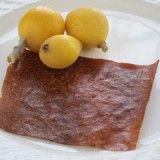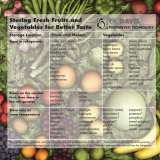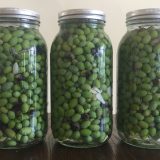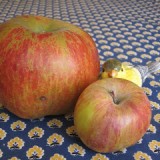
The Karp’s Sweet quince in our front yard, despite struggling in terrible soil, has finally started producing. This year we got about three pounds. Some of the fruit gets sunburned (note to self–put up some shade cloth next year!). But I’ve been able to cut out the browned part.
Each year the question comes up as to what to do with the fruit. You can eat Karp’s Sweet quince raw, but the texture is still quince-like, which is to say somewhat gritty and course. And each year I promise I’ll pick up a copy of Barbara Ghazarian’s comprehensive book Simply Quince, but somehow I never get around to it.
Last year I tried to make quince jelly, but overshot the jell point and ended up with jars of delicious tasting, but disagreeably hard quince gum. And Kelly just threw out my burned membrillo from last year.
This year Kevin West, author of Saving the Season came to the rescue with an ancient (the first known reference to a sweet preserve) and simple recipe by Pliny. The full recipe is on West’s website, but to summarize you simply cook quince in equal parts honey and water until it turns red. The addition of a small amount of cracked pepper cuts the sweetness ever so slightly. You can then process the jars in a hot water bath. The end result is quince slices preserved in honey. It turned out great and, without having to worry about the jell point, reduced the anxiety level associated with preserving my entire harvest at once.
Do you have a quince tree? What do you do with the fruit?






That sounds fantastic. We’re just getting ready to harvest the quinces, so perfect timing. We get a lot of quince and typically make membrillo with it – enough to last all year and to give tons away. Some years, I also make pectin. If you use a lot of pectin, you can probably make it a lot more inexpensively from quinces than you can buy it.
I make quince jelly because it is so easy!
I use a steam juicer to effortlessly extract the juice, add sugar, cook until it reaches 220, then can.
I am not an experienced jam maker, but this is great.
A steam juicer is a great idea!
Where did you get your quince tree? I was looking for one but having a hard time finding one. Looked into an Aegle marmelos instead. Thought it was too warm for quince here.
Raintree nursery. But I’d suggest getting one from Bay Laurel Nursery–get your order in now for January delivery. They sell out fast.
I don’t yet have a quince tree, but I want one… Even if all I did was to bring the wonderful smelling quince fruit indoors to perfume the house that would be a treat. I love the flavor of quince. You can add a bit of quince to apple pie for a lovely flavor. I have made quince jelly (hint: the crockpot is your friend) but my favorite thing to do with quince is to make “quincemeat” a sweet and spicy conserve that is fantastic to use for winter holiday sweets. I posted a recipe on my blog a few years ago, and try and make some every year.
http://artisanry.blogspot.com/2010/12/tigress-can-jam-quincemeat-preserves.html
I ordered my lemony quince from oikos tree crop. Look forward to planting it next month.
thanks for this site Jamie!! Looks great – and in Michigan so i can feel secure that the plants will do well in my upper NW Indiana location!
We have quince and just tried jamming it this year. I sliced up a bunch and cooked it with “some” sugar (to taste, since I wasn’t planning on canning it). In keeping with my overactive spice enthusiasm I added vanilla and almond extract, a little cinnamon, and candied ginger. The result was greatly appreciated and we finished the jar in a week. Fortunately we have more quince!
That sounds amazing. And a great idea to do a refrigerator jam to avoid high sugar levels.
Hi there, that looks like an excellent recipe.
We usually make several things with quince. The main one is a jelly, for this you cook the quince untill soft (peeled and de-seeded, add only some clean peel for the color), let it stand overnight, then filter and only cook the juice with the sugar and pectin, quince is among the high-pectin fruit so any added pectin has to be on the lowest end of the scale.
This year I also made cordial, adding lemon juice and lemon acid to prevent it from thickening up.
We also make membrillo, the spanish way. It goes super well on cheese plates and on some pies, eg. with butternut squash and stilton! Membrillo is a bit of a complicated process, but it keeps for ever in the fridge: http://www.simplyrecipes.com/recipes/membrillo_quince_paste/
My favorite ways are both italian inspired:
A bake: clean, half and de-seed quince but leave their skin on, inside the quince add some butter and dark sugar (mascobado), turn them upside down in butter in an over dish, squeeze lemon over it, and bake for 30 min. or until nicely burned/caramelized. Add some cream fraiche and sugar and eat with a spoon.
A compote: For the other recipe you peel and de-seed you quince, cut it into slices and cook it in a sirup of water, sugar, peppercorns, orange zest, bay leaves, lemon juice and red wine. This can be eaten with bitter salads or sweet with some cream fraiche.
Now I’m sad that Erik made all of our quinces into jam!
My quince are all bushes. Do they grow up to be trees?
Mine is very small too. I think they are a small tree, at least all the ones I’ve seen.
Our oldest quince is ten years old and is a 14 foot tall tree. They do tend to get bushy if you don’t keep them pruned for tree form. You might also have ornamental quince (Chaenomeles sp.) which is a bush.
My dad made quince jam all through my growing up, based on a “recipe” from his mom. Now I make it too. VERY easy and good:
1. Peel, core and chop quinces as if you were making applesauce.
2. Put in a saucepan with about an inch of water. Simmer until they turn red, 2-3 hours, or longer. Add water as needed so they don’t burn.
3. Add sugar to taste, and a bit of lemon juice if you feel like it. (I keep the sugar low and refrigerate the jam – its always gone within a week anyway.) Cook about 20 minutes more with the sugar, being very careful not to let it stick.
The smell of quinces simmering on the stove all day is the most nostalgic smell of fall for me.